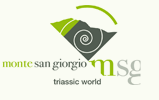Clivio (I)
The town of Clivio is located in the north west part of Italy, in the province of Varese, about 15 km from this city. The etymology of the name of Clivio, which means laying on a hill, explains very well the position and the characteristics of the town, because it is situated on a hill which overlooks the beautiful valley of Mendrisio and some areas of Como. From its hills you have an astonishing view of the Swiss town of Chiasso, the funicular of Brunate and the famous "panettone" ( lonely mountain) of Montorfano, the last hill before the plain of Brianza.
The eastern panorama also offers an amazing landscape: the Monte Generoso (1700 meters) still in Swiss territory.
Entering the town from north, it is important to observe how the old town is really located on a "Clivio", ie a hill, with the river Lanza at the base which, flowing underneath the village, takes the very name of the town: Clivio stream. Along this creek two mills are still visible: the Mulino Di Sopra (the Mill Above), tracking back to 1550, until 1940 it was a textile mill and the Mulino di Sotto (the Mill Below) of which few traces remain. However in this area there is a small and charming hamlet (under renovation by private citizens) that makes the very idea of the history and the life of the past.
Of particular interest are the three churches in the town and several old buildings including the building called the “Casa Reale” in which the Monk and philosopher Giordano Bruno dwelled during the last years of the 17th century. In the building in Via Albuzzi, now partly restored, you can visit a place of the past with colonnades and arcades, which is now the seat of the municipal library and recreation center for the elderly, while the courtyard in front of the block is used for parties and meetings proposed to the population by local associations. The palace of the Casa Reale is an interesting structure that dominates the center of the town.
There are also three churches of considerable interest: the Parish dedicated to the Patron Saints Peter and Paul, with the adjacent ossuary built at the end of the 16th century, the Church of St. Maternus, also of the same period, and the small Church of Santa Maria della Rosa privately owned, perched on top of the village and set in a beautiful natural environment, characterized by few but renowned vineyards that every year produce an excellent red wine thanks to the passion of the nearby Swiss winemakers. Historical records ascribe its construction to the ancient Romans who already used the area as a Lazaretto.




